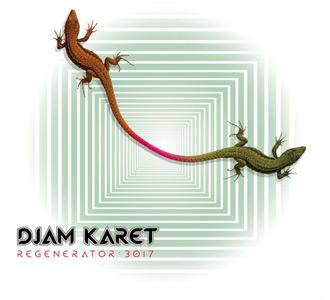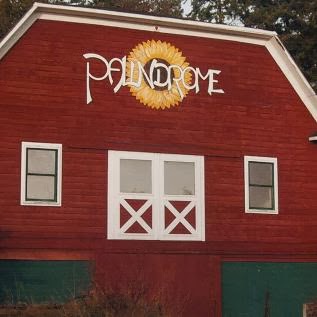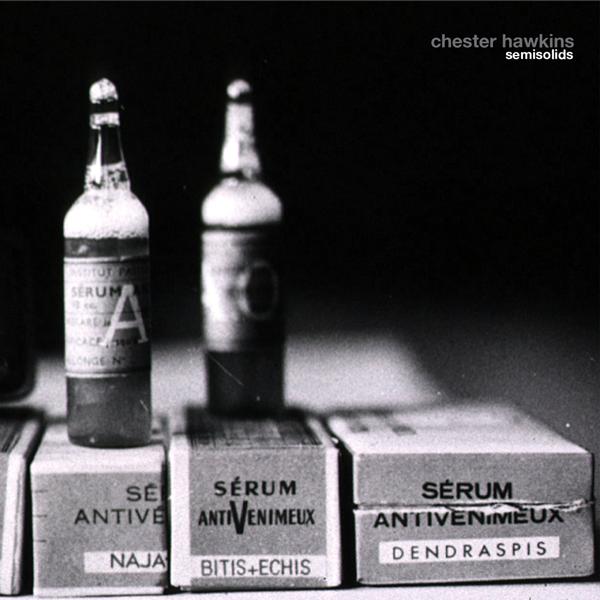 Djam Karet’s 17th album is a 30 year celebration of this band that formed in southern California in 1984. Throughout the years Djam Karet has covered a variety of territory, including Progressive Rock, Hard Rock, Psychedelia, and ambient/soundscape explorations. All these elements came together on their last album, 2013’s The Trip, which consisted of a single 47 minute journey. For Regenerator 3017, which includes all the original band members, we have Djam Karet in full blown 70s inspired Prog mode, though there are spacey psychy bits to be enjoyed as well.
Djam Karet’s 17th album is a 30 year celebration of this band that formed in southern California in 1984. Throughout the years Djam Karet has covered a variety of territory, including Progressive Rock, Hard Rock, Psychedelia, and ambient/soundscape explorations. All these elements came together on their last album, 2013’s The Trip, which consisted of a single 47 minute journey. For Regenerator 3017, which includes all the original band members, we have Djam Karet in full blown 70s inspired Prog mode, though there are spacey psychy bits to be enjoyed as well.
Prince Of The Inland Empire sets the tone for the album, having a Canterbury-Prog and Jazz-Fusion feel, augmented by beautifully tasteful and melodic guitar solos and killer sounds of the 70s keys. Living In The Future Past is similar but heavier on the Jazz-Prog-Fusion side, and includes cool grooving Rhodes and luscious spacey Mellotron. Desert Varnish starts off sedately floating, and then develops into a spacey Prog instrumental, and we’re treated to impassioned acidic rocking guitar licks, spacey keys, soundscapes and alien effects. The freaky effects continue on Wind Pillow, along with awesome melodic and spaced out guitar leads on this blend of classic Prog, Fusion and Psychedelia. Lost Dreams demonstrates how a simple peaceful grooving vibe can be so exquisite when you have the combination of scrumptious guitar and keyboard sounds and rip your heart out melodies. Ditto for the dreamy sauntering melodic Empty House. And On The Edge Of The Moon is at once the most intense and most majestic track of the set.
Wow, 30 years is serious longevity by any measure. What’s kept me excited about Djam Karet all this time is their ability to follow an exploration like The Trip with a 70s Prog influenced but distinctly Djam Karet experience like Regenerator 3017. The promo sheet describes the album’s intent as, “we wanted to create a melodic album with a classic sound.” I’d say that nails it. The combination of monstrous melodies and classic sounds are striking. 30 years and going strong. You ROCK Djam Karet…
For more information visit the Djam Karet web site at: http://www.djamkaret.com
Reviewed by Jerry Kranitz

 Gritty, raw and earthy are not usually words associated with progressive rock. So it was strange to me at first that these words would come to mind while first listening to progressive rock group Glass’s new album, Palindrome. They are apt descriptors, although they don’t quite tell the whole story. The album is quite a unique listening experience.
Gritty, raw and earthy are not usually words associated with progressive rock. So it was strange to me at first that these words would come to mind while first listening to progressive rock group Glass’s new album, Palindrome. They are apt descriptors, although they don’t quite tell the whole story. The album is quite a unique listening experience. The Golden Path EP is not the new Space Mirrors album, but rather a 10 year anniversary digital download only collection of re-recorded songs, previously unreleased outtakes and demos from the early years. It’s also, in terms of length, not an EP as it includes over 70 minutes of music.
The Golden Path EP is not the new Space Mirrors album, but rather a 10 year anniversary digital download only collection of re-recorded songs, previously unreleased outtakes and demos from the early years. It’s also, in terms of length, not an EP as it includes over 70 minutes of music. Washington, DC based musician Chester Hawkins first came to my attention through his recordings as Blue Sausage Infant, a project he decided to retire after 28 years and now continues to record under his own name. While Blue Sausage Infant was Hawkins’ own project, from one album to the next it could include a variety of guests. Semisolids is (I believe) Hawkins’ first post-BSI release, and all tracks were improvised live with no assistance from collaborators.
Washington, DC based musician Chester Hawkins first came to my attention through his recordings as Blue Sausage Infant, a project he decided to retire after 28 years and now continues to record under his own name. While Blue Sausage Infant was Hawkins’ own project, from one album to the next it could include a variety of guests. Semisolids is (I believe) Hawkins’ first post-BSI release, and all tracks were improvised live with no assistance from collaborators. Bill Nelson isn’t what I would describe as space rock or psychedelic. But his 1970s band Be Bop Deluxe certainly had sci-fi and futuristic themes. And there’s an ambient/soundscape quality to much of his solo work. I followed him closely from the Be Bop years through the mid-80s and then lost track of him until last year when I learned of a new book biography, which I picked up and enjoyed. Cherry Red’s Esoteric label, in conjunction with Nelson’s own Cocteau Discs. has reissued Nelson’s 1986 Getting The Holy Ghost Across (aka On A Blue Wing), which is probably the first, or one of the first, of his albums released after my attention was diverted in the 1980s.
Bill Nelson isn’t what I would describe as space rock or psychedelic. But his 1970s band Be Bop Deluxe certainly had sci-fi and futuristic themes. And there’s an ambient/soundscape quality to much of his solo work. I followed him closely from the Be Bop years through the mid-80s and then lost track of him until last year when I learned of a new book biography, which I picked up and enjoyed. Cherry Red’s Esoteric label, in conjunction with Nelson’s own Cocteau Discs. has reissued Nelson’s 1986 Getting The Holy Ghost Across (aka On A Blue Wing), which is probably the first, or one of the first, of his albums released after my attention was diverted in the 1980s.